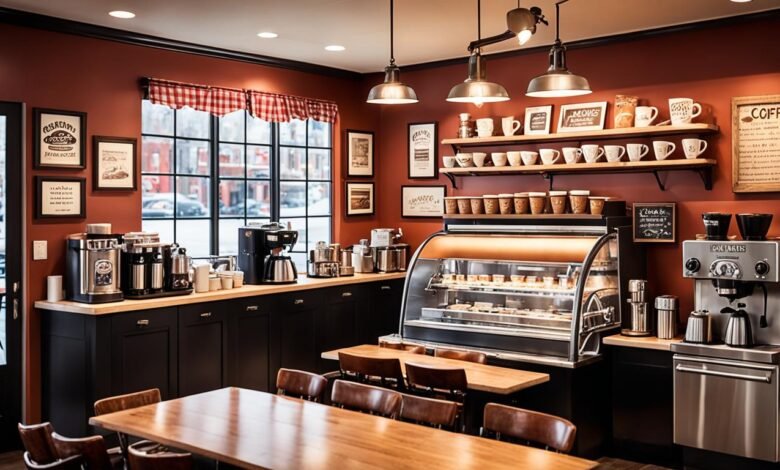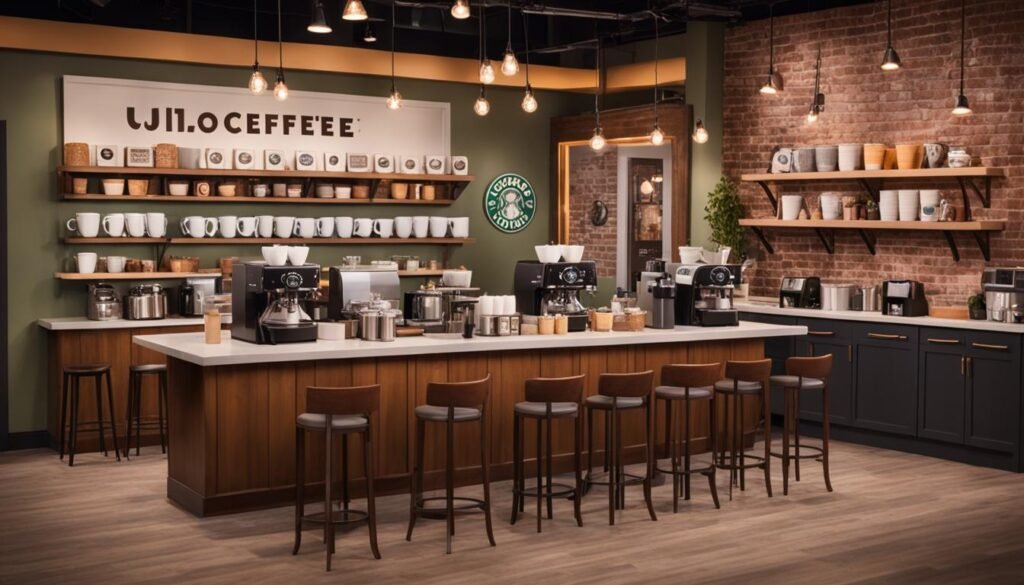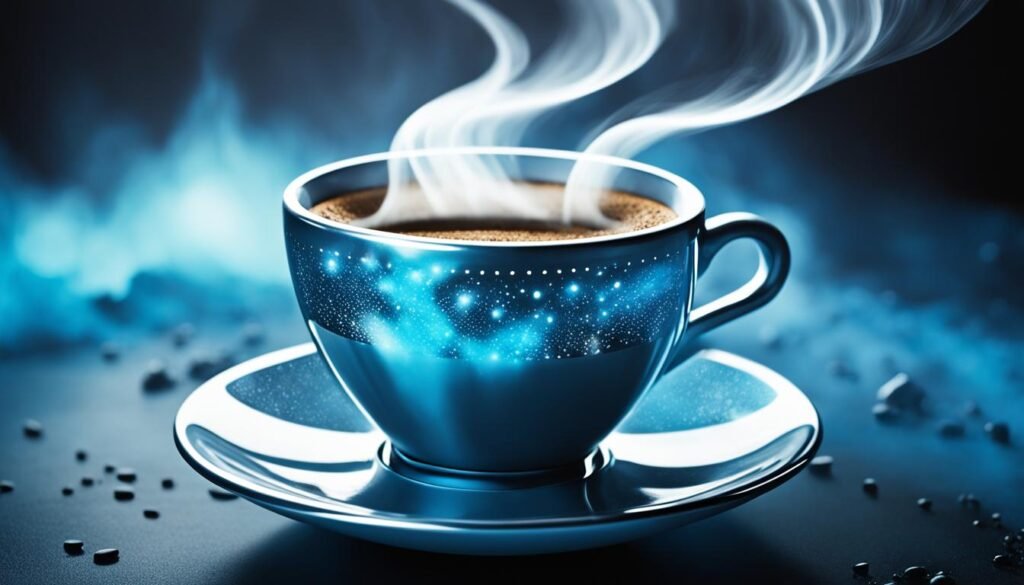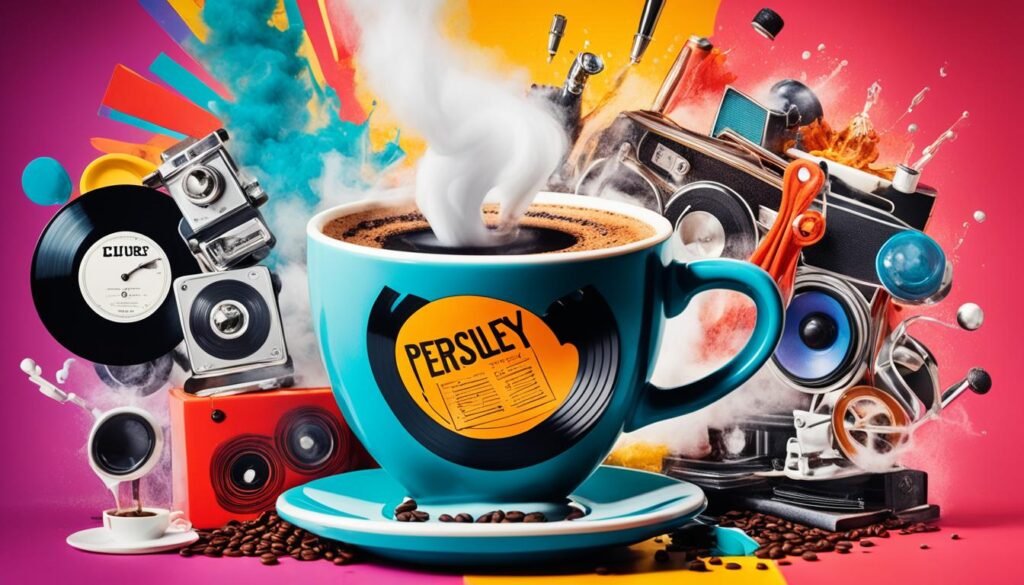Coffee in Popular Culture

As we sip our morning brew, we notice coffee’s big role in our lives and culture. It’s everywhere, from busy coffee shops to movies and music. Coffee has become a big part of how we connect and experience the world.
Coffee is more than just a drink. In the 1960s, it was linked to rebellion and change. Young people met in coffeehouses to talk and challenge the norm. Now, it’s seen as a key to being productive, creative, and starting the day right.
From memorable scenes in movies like “When Harry Met Sally” to deep coffee shop talks in “Pulp Fiction,” coffee is a big part of movies. It even shows up in video games like “Final Fantasy.”
Coffee is important for more than just fun. It’s where people meet, work together, and get inspired. Shows like “Friends” and “Gilmore Girls” feature characters who love coffee. Even sports teams, like the Los Angeles Dodgers, use coffee to connect with young fans.
Key Takeaways
- Coffee is a big part of popular culture, changing how we see things and live our lives.
- Coffee’s importance goes beyond the West, being a big part of many cultures.
- Specialty coffee shops and the art of making coffee have made it even more popular.
- Coffee is in movies, TV shows, and more, helping to keep its influence strong. It often helps set the scene and brings people together.
- Coffee is linked to energy, being productive, creative, and starting the day, symbolizing the morning.
The Iconic Coffee Shop Scenes
Coffee shop scenes have a special spot in movies, bringing us memorable moments. These cozy cafes have become key parts of popular culture. They boost the feelings and interactions of the characters on screen.
When Harry Met Sally’s Comforting Coffee Shop Ambiance
The 1989 movie “When Harry Met Sally” has a famous coffee shop scene. It shows the warmth and buzz of a café, with characters sharing a deep talk. This scene highlights the growth of their relationship. The coffee shop’s vibe matches the characters’ feelings, showing how coffee culture in movies can touch our hearts.
The Intense Dialogue in Pulp Fiction’s Coffee Shop Scene
Quentin Tarantino’s “Pulp Fiction” has a coffee shop scene full of tension and intensity. The characters’ captivating dialogue in a dim café adds mystery and suspense. This scene is key to the movie’s story and has made coffee a big part of popular culture.
These coffee shop scenes are more than just settings; they’re symbols of the characters and their tales. They grab audiences and leave a lasting impact on movies.
Memorable Coffee Moments in Movies
Coffee has made a big impact in movies, becoming a key part of popular culture. Who can forget the “I’ll Have What She’s Having” line from “When Harry Met Sally”? Or the intense “Coffee is for Closers” scene in “Glengarry Glen Ross”? These moments have not only entertained us but also made coffee a big part of our culture.
The “I’ll Have What She’s Having” Line from “When Harry Met Sally”
The “I’ll Have What She’s Having” scene from “When Harry Met Sally” is a classic. It’s often parodied and mentioned in other media. This scene shows how coffee can bring people together, creating a cozy atmosphere in a coffee shop.
The “Coffee is for Closers” Scene in “Glengarry Glen Ross”
The “Coffee is for Closers” scene in “Glengarry Glen Ross” shows the tough side of some jobs. The phrase has become a symbol of hard work and success. It shows how coffee is seen as a motivator in many areas of life.
These coffee moments in movies have done more than just entertain us. They’ve made coffee a big part of our culture. From helping us connect with others to showing the drive for success, coffee is now a key part of movies and our culture.
Coffee in Popular TV Shows
Coffee is a big part of TV shows today. The famous Central Perk coffee shop in “Friends” symbolizes friendship and togetherness. It was where the main characters met, laughed, cried, and enjoyed coffee together.
The Central Perk Coffee Shop in “Friends”
“Friends” showed coffee shops as places for deep talks and making friends. Central Perk and its orange couch are symbols of the show’s focus on relationships and coffee’s role in them.
In “Frasier,” coffee was key to the characters’ stories and identities. The Café Nervosa was where they met, talked, and showed off their coffee tastes. Niles Crane started off seeming snooty about coffee but changed over time.
“Seinfeld” also had a coffee spot, Monk’s Café, where the friends would hang out. It wasn’t just a coffee shop but a place for their witty conversations. Coffee’s role in these shows highlights its importance in our culture.

Coffee in TV shows mirrors its role in our lives. It brings people together, helps create deep bonds, and sparks memorable stories. As viewers, we see how coffee makes a difference on screen.
Coffee Popular Culture
Coffee is a big part of our daily lives and culture. It helps us start the day with energy and focus. It’s the drink of choice for many, from busy professionals to students needing a morning boost.
Coffee is also linked to creativity. Artists, writers, and musicians often find inspiration in it. They value the ritual of making and enjoying coffee.
Specialty coffee shops have made coffee even more popular. A new group of coffee lovers is exploring the art of coffee. They appreciate the details of sourcing, roasting, and brewing.
| Coffee Trends | Percentage |
|---|---|
| Americans who drink 2 or more cups of coffee every day | 68% |
| Millennials and Gen-Z willing to pay more for a unique coffee experience | Younger generations |
| People willing to pay more for coffee if the company is committed to a positive environmental impact | 66% |
Coffee has made its mark in popular culture, even in iconic shows like Star Trek.  Pop Culture Coffee offers special Star Trek coffees. They have unique blends and packaging with favorite characters.
Pop Culture Coffee offers special Star Trek coffees. They have unique blends and packaging with favorite characters.
Coffee is now a big part of our lives and culture. It goes from our morning routines to the art of coffee appreciation. Its impact on popular culture is strong and keeps growing.
The Rise of Coffee Culture
We’re seeing a big change in coffee culture lately. Specialty coffee shops and third-wave coffee roasters have played a big part in this change. They’ve brought in a new kind of coffee lover who values the skill and care in making top-notch specialty coffee. These fans are into the whole process, from where the coffee comes from to how it’s roasted and brewed. They’re also happy to spend more for a great coffee experience.
Coffee culture has changed how we drink and think about coffee. It’s also made coffee a big part of popular culture. We see it in coffee-themed events, products, and online trends. This shows just how much coffee culture has taken off in today’s world.
- Specialty coffee has become a big deal, drawing coffee lovers from all over the world.
- Gourmet coffee has changed the coffee industry a lot, showing that people want better quality coffee.
- Coffee culture has made coffee more than just a drink. It’s turned coffee shops into places where people meet and hang out.
- Now, people see coffee as a choice of lifestyle, drinking several cups a day as part of their routine.
| Coffee Culture Trend | Impact |
|---|---|
| Gourmet coffee | Has changed the coffee scene by offering unique tastes, custom brews, and a special experience in specialty coffee shops. |
| Coffee shops as community spaces | Have become key spots, offering top-notch coffee and places for cultural events and social meetings. |
| Specialty coffee brewing methods | Have become more popular with coffee fans, showing a desire for complex and rich flavors. |
The growth of coffee culture has really changed how we view and enjoy coffee. As we keep exploring and enjoying the wide range of flavors and experiences in coffee culture, we’re looking forward to an even more exciting future for coffee in our lives.

“The evolution of coffee culture has transformed the way we see and experience this beloved beverage, creating a new era of appreciation and passion for the art of coffee.”
Coffee Symbolism and Representation
Coffee has grown beyond just a drink to a symbol in our culture. It shows comfort, connection, and community. Sharing coffee is seen as a way to welcome others and talk deeply. Coffee shops are places for deep talks and sharing ideas, helping people form strong bonds.
Coffee is also linked to creativity, seen as a spark for artists and thinkers. Its role in culture has made it a big part of our lives, influencing how we see and use it.
Worldwide, coffee tastes vary greatly, from creamy egg coffee in Vietnam to cardamom coffee in the Middle East. It’s not just a drink anymore but a key ingredient in desserts like tiramisu and a flavor booster in many dishes.
| Coffee Consumption Patterns | Significance | Global Influence |
|---|---|---|
| Coffee’s caffeine content varies significantly based on different factors like the type of bean, roast, and brewing method, influencing its appeal and health considerations for consumers. | Coffee’s historical journey from its discovery by Kaldi in Ethiopia to its transformation into a symbol of sophistication, enterprise, and culture in regions like Yemen, Venetian palazzos, and American urban landscapes. | The global coffee market is characterized by established coffee hubs with rich histories like Brazil, Indonesia, Yemen, and India, each contributing to the diversity and evolution of coffee culture worldwide. |
Over time, coffee has changed from a drink for monks to a social drink in Europe and now helps us stay connected and productive. In the 17th century, French coffeehouses were hotspots for new ideas and debates.

Now, coffee’s meaning is changing, especially with younger people. Seattle, known for its coffee culture, is also a hub for tech and innovation. As coffee grows in popularity, its symbolic value stays strong, influencing our stories and traditions.
Conclusion
Coffee has become a big part of our culture, more than just a drink. It symbolizes energy, productivity, creativity, and community. It’s seen in movies and TV shows, and is part of our morning and social routines.
Coffee has become a big part of our. The specialty coffee culture has made people appreciate the art of making coffee more. This has led to a new group of coffee lovers who enjoy the details of coffee.
Coffee’s role in popular culture is still growing. It’s popular in movies and enjoyed with friends. This shows how much coffee affects our culture and lifestyle. Coffee helps us start our day and brings people together for conversations.
So, coffee will keep being a key part of our culture. It’s always there, supporting our daily routines and bringing people together. It’s a big part of our coffee culture and lifestyle.






